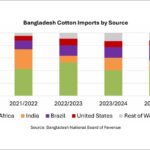Polar Bear-Inspired Fibre: A Sustainable Textile Revolution

A innovative fibre developed by scientists at Zhejiang University in China has the potential to revolutionize the textile industry. Led by Associate Professor Gao Weiwei and Professor Bai Hao, the research team drew inspiration from nature, particularly the polar bear, to address the limitations of traditional aerogel.
Traditional aerogel, despite being widely used in aerospace, faces challenges due to its fragility and difficult processing. It lacks the strength and stretchability required for practical textile applications and is not machine washable, losing thermal insulation in wet conditions.
The research team designed an encapsulated aerogel fibre (EAF) with a core-shell structure, inspired by the polar bear’s unique hair structure. Mimicking the porous core enclosed within a dense shell of polar bear hair, the team developed a polymeric aerogel fibre encased in a thin, stretchable rubber layer. This innovation overcomes the brittleness associated with traditional silica aerogel, making the EAF bendable and twistable.
The EAF exhibits remarkable properties, being stretchable up to 1,000 per cent strain, far surpassing traditional aerogel fibres. The practical applications of EAF are extensive, demonstrated by weaving a jumper with thermal insulation comparable to a traditional down jacket, but only one-fifth as thick. In a -20 degree Celsius environment, the EAF outperformed down, wool and cotton in maintaining surface temperatures.
Unlike traditional silica aerogel, the EAF is washable and dyeable, making it suitable for everyday textile use. The researchers highlighted its potential for multifunctional use beyond thermal insulation textiles, retaining its properties even after 10,000 stretching cycles.
While civilian applications are vast, challenges exist in mass production, as noted by Professor Zhang Xuetong of the Suzhou Institute of Nano-tech and Nano-bionics. He emphasized the need to develop fast spinning technology for continuous fabrication required for mass production. Despite challenges, the EAF’s potential use in military uniforms and space suits in extremely cold environments is noteworthy.
The findings of the research team were published in the journal Science, marking a significant step forward in unlocking nature’s secrets for advanced fibres.














